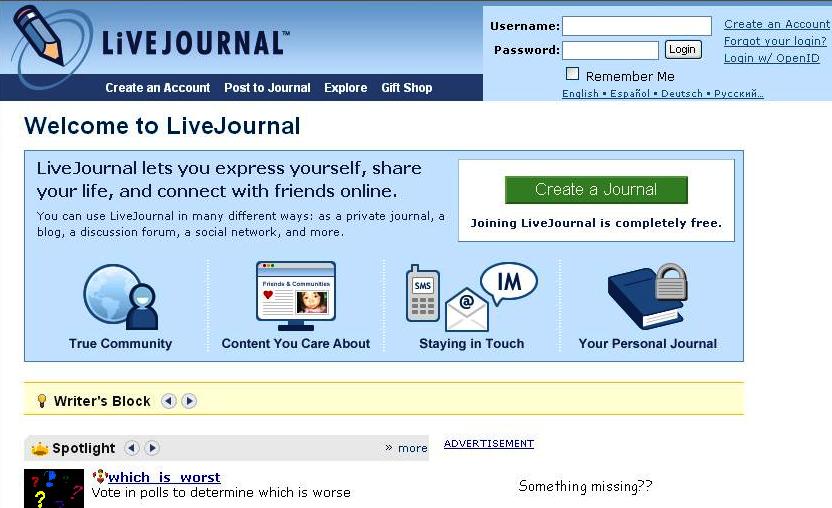Scan Magazine: 2007-10-10
Social Interactions on LiveJournal: Fandom Interactivity
It is given that on the internet, interactions between people previously unknown to each other in the physical world are de-personalised due to the inability of ensuring a face to face meeting at every point of interaction. Also due to the proliferation of identity creation through the mass availability of representative symbols, the image and the reality of the social actor may greatly vary from one another.
We can centre on the study of fandom communities on the internet and how their interactions mimic or detract from real life. For analysis, I have focused on a specific number of fandom-based communities hosted on a popular networking tool, LiveJournal.

LiveJournal allows for blogging as well as connecting one's blog to another through a network function, which further acts as what is termed by LiveJournal as a "community". Members of similar interest, which can be listed and aggregated by the LiveJournal algorithm, can then meet and interact by crossposting comments on one another's personal blogs. Members of a specific "community" can then also create a mirror "journal" linked to their "community" journal (which functions as a newsgroup noticeboard) featuring newly updated member journals. Thus the interactivity of blogging is intensified - forming a simulacrum of a little "global village", as the LiveJournal tool is accessible to most parts of the world.
These few communities of fandom were chosen because they are easy to analyse - that is, the cultural references within the fandoms specified are easily accessible to the public due to its ubiquity in pop culture. They are respectively two fandoms centering around two literary icons, and one more on a historical figure which has been immortalised on film.
Activities of these fandoms largely include fanfiction writing, fanart, and making fan videos, now that YouTube has become a household tool. Fanfiction is essentially a form of fiction involving favourite characters in any given literary or real universe, in situations created by the authors. Similarly, fanart is the visual companion to it. Fan videos may be made either using these fanart images, or clips from the particular movie that is then edited together using electronic tools such as Windows Movie Maker.
In fandom, as in real life, there are those who are active participants in a community as well as those who are less active. There are also those who are demanding of high standards in production of knowledge, and those who are not. Hence in fandom, one can easily spot interactions centering around the criticism of peer writing, such as what is termed "bad fiction" or "badfic" which are basically fanfiction written in a slipshod manner or those which do not meet specified criteria, just as in the world of publishing. There may then be communities within a similar fandom which houses the said badfic created solely towards deconstructing (or rather tearing to shreds) the "badfic" found in the fandom.
What is of particular interest in this article is the manner in which actors go all out to locate, and then on to tear apart (and quite often too, make fun of) the pieces which they term "badfic" seemingly without regard to the response of the author. Perhaps it is an established culture; UseNet groups in the early days of the Internet in the 80s were set up to discuss the pros and cons of other Internet applications, which would have resulted in similar interactions. Perhaps also it is the fact that the interactions of the actors are limited in the sense that they do not speak face-to-face; therefore they do not relate to each other using facial expressions and the display of emotions as one would do in the physical world. Thereby emotional responses might be hard to gauge, and it is much easier to ignore these. Once the trend has become widespread, people grow accustomed to overlooking this factor in communication.
This echoes a recently published research on emailing and its revolutionising of communication which talks about how an email may make or break relationships as well as your career. A badly thought out email, once sent out can do negative wonders for one's social circle. A badly worded email can damage a person's feelings; despite the sender completely overlooking the effects of the choice of words. Conversely, in conversation face-to-face, one can always know when to stop talking when one's listener begins to show signs of discomfiture. As email is so easy and quick to release, coupled with the fact that it costs virtually nothing, the protocols normally reserved for a well-composed letter sent by air may be omitted by the need for speed. After all, it's nearly a matter of pressing "Delete".
The author's responses to postings on the aforementioned deconstruction range from completely ignoring them to questioning the criticism, which is relatively rare. However, one can safely say that the deconstructors are usually highly educated, with significant cultural capital, as evidenced through their writing skills and method of analysis. The deconstructors may also have their own personal blogs/journals, which provides an insight into their own writing, which are usually of greater literary promise than those being criticised. It is remarkable that such promising talents themselves spend considerable time, even starting up a community journal, literarily deconstructing pieces much inferior to theirs.
Rachel Chan Suet Kay is a Sociology graduate of the University of London.